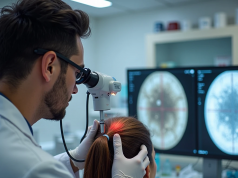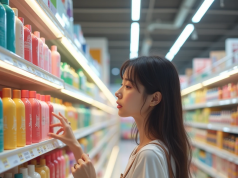The main step in hair care is the process of washing hair. Before starting the process of washing the head, everyone should have at least a remote idea about the structure of hair. The process of hair birth takes place inside the hair follicle. The follicle itself receives useful substances necessary for hair growth from inside the body. Consequently, the health of the hair directly depends on the condition of the body.
The hair itself is a shaft covered with horny scales that are tightly adhered to the hair shaft. Information about hair structure can come in handy for anyone who in hair care regularly trims the ends, or makes a haircut for the hair. Knowing the structure of the hair, it is easy and simple to choose hairdressing scissors that would not "tear" the hair. A collection of such scissors can be seen on the website of the online store "Salonchik Beauty", specializing in the sale of beauty tools. Here are the most different types of scissors: Japanese scissors, filing scissors, filers, ergonomic scissors. All presented scissors of German company Comair, are made of high quality steel, with ergonomic design and a special type of sharpening. All types of scissors have a unique cutting ability. Such scissors should be at home. And when visiting a hairdresser's shop, it will not be unreasonable to ask the master what kind of scissors the master uses.
As soon as we apply alkaline shampoo to the hair, the scales seem to "stand up" and the natural protection of the hair is washed away by the alkaline composition. This leaves the hair completely defenseless. This is why it is very important to structure the hair washing process in such a way that the scales are restored to their normal state and the protective film is restored.
First step
Choosing a shampoo. Exactly shampoo. Because you can't wash your hair with soap. Soap, reacting with substances from the composition of tap water, leaves a film on the hair and scalp, which can seriously traumatize the hair.
Shampoo is not chosen by the amount of foam it produces. The foam is created by special substances "foaming agents", which have nothing to do with cleansing the hair and scalp. This is just a marketing move for gullible and naive buyers. When choosing a shampoo, you should pay attention to both the amount of surfactants and their quality. For example, laureth sulfate, a well-known surfactant, it perfectly rinses the hair in both soft and hard water.
For oily hair, shampoo should contain at least two types of surfactants.
For dry, thin or damaged hair, a shampoo can include just one surfactant. But it must be a powerful surfactant capable of removing all dirt.
If the shampoo is not properly selected, the hair will become very lush after washing, it will become electrified and the ends of the hair will start to split. This is due to the fact that the wrong shampoo "ruffles" the scales so much that they remain in this state even after the end of the washing process.
However, you should not be in a hurry to throw away the old shampoo. Rewrite down its composition. And when buying a new one, compare the composition, so that you do not buy a copy of the old shampoo. It does not matter that you buy shampoo of another brand. A double can be in any brand.
Rules for shampooing your hair:
- You should not shampoo your scalp twice, as this washes away the hair's natural defenses.
- Shampoo is best not rubbed into the scalp.
- Shampoo should not create a heavy lather, regardless of whether you wash your hair in hard or soft water.
- Shampoo is only for cleansing the hair and scalp. Shampoo should not be left on the hair for a long time during washing. Nor should you shampoo your hair twice. Even if it feels like the hair is not rinsed the first time, it does not squeak under your hands and feels stiff and tangled.
Step two - is to restore hair after alkaline shampoos. The nature of hair is such that the hair shafts are coated with a thin, waterproof greasy film. This film is produced by the sebaceous glands to protect the hair from the outside world. It is this natural fatty film that gives hair its natural shine and makes it soft and supple. In order to restore the hair's protection, conditioners or conditioners are used after shampoos. After shampoo is washed off, and washed off completely, hair conditioner is applied. It should be rubbed with massage movements into the hair and scalp, leaving it on the hair for 2-5 minutes. The conditioner should be rinsed off well. This is the only way of washing the head, in which the hair is not traumatized, remaining light, manageable, shiny.
Air conditioners should be used by everyone without exception, regardless of hair type. This is especially true for those who have oily hair and require frequent use of alkaline shampoos. For oily hair, you should wash your hair once a week with therapeutic shampoos that contain either salicylic acid or tar. These shampoos will rid the scalp of dandruff that often forms on oily hair. The perfect men's haircut it's not going to work.
If at the end of the washing process you still have the unpleasant feeling that artificial chemicals are left on your hair, try rinsing your hair with something acidic - apple cider vinegar or freshly squeezed lemon juice dissolved in plenty of water. This is to balance the acid-alkaline balance of the scalp and hair. For oily hair, it is better to use acid in between the use of shampoo and conditioner.
If you feel that a particular shampoo causes an itchy scalp, stop using it immediately and switch to a different brand of shampoo. Be sure to write down the composition of the shampoo and try to find out which ingredient in the shampoo causes an unpleasant reaction. Otherwise, it can lead to the appearance of allergies on the scalp. Usually scalp irritation is caused by dyes, chemical fragrances or preservatives. Try to choose shampoos that have a different composition than the shampoo that caused the irritation.







Thank you for the simple and clear explanation. I used to wash my hair with soap sometimes, but now I will probably use only shampoo. Although in stores sometimes sold soap, which says "for body and hair", I wonder such soap also can not wash the head or still it can be used along with shampoo?
No soap should be used to wash your hair. There are no ingredients in any soap that can wash away dirt, grease and sebum from the hair. If you wash with soap, you will get dandruff.
Very informative and useful article. Learned a lot about how to properly care for my oily hair.
Very informative article! And I always wash my hair twice, it turns out it is harmful. And I use balm about once a week. Thank you for the information. I didn't realize it was so serious. Now I will reconsider my process of washing my hair, and shampoos too. With oily hair, how often should I use a hair mask? Or is it the same balm, but with a different name?
Oily hair after shampooing and conditioner rinse with something sour, for example, a tbsp. of lemon juice diluted in 3 liters of water. If your hair is oily, you should first reconsider the washing process. When there is too much alkaline shampoo, then the hair itself has to protect itself by secreting a lot of sebum. As a result, the hair becomes greasy. And if you wash your hair according to the scheme - shampoo - conditioner - then the greasiness will disappear. Not tomorrow, of course. But in a few months hair will stop being greasy.
Thank you so much!!! Very helpful!
[...] Apply the mixture to your hands and rub it into your scalp and hair. Leave it on for a few minutes and then rinse it off with shampoo. Then be sure to apply conditioner. Rinse your hair well. [...]
Hello! My chemist friend says that skin cells have a negative charge, cationic emulsifiers contained in balms are attracted to the negative cell and destabilize its work. And almost instantly, up to and including the appearance of dermatitis. Maybe there is some way to reduce the harmful effects of cationic emulsifiers on the skin if we wash our scalp with a balm?
Hello. You can get the information you need with a detailed breakdown of all the details you'll find in this article